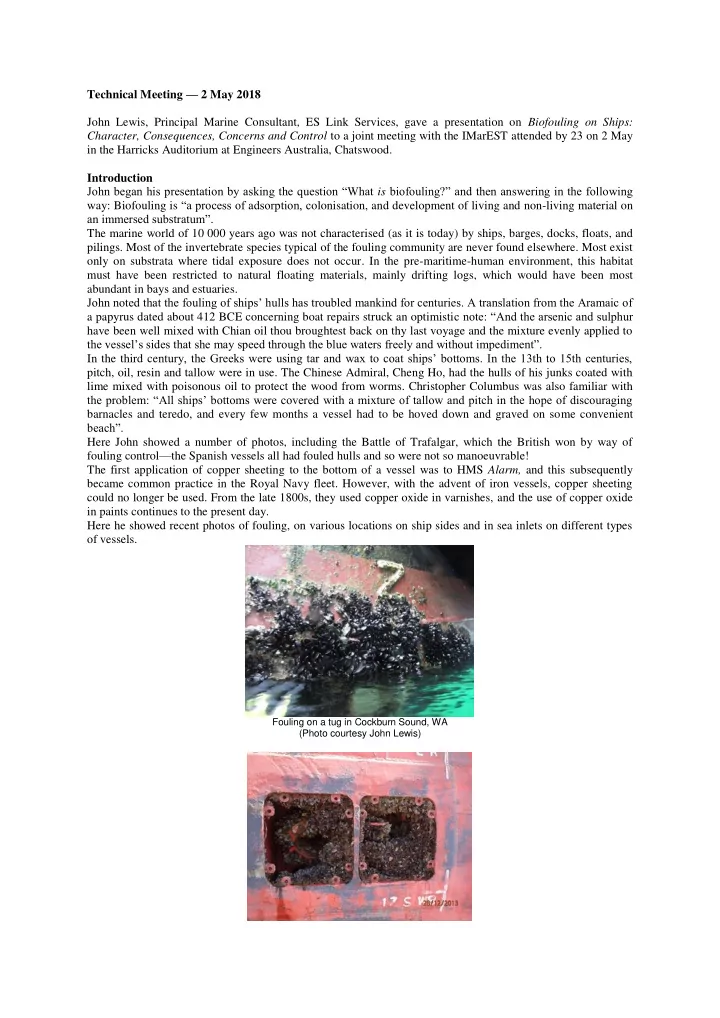

Technical Meeting –– 2 May 2018 John Lewis, Principal Marine Consultant, ES Link Services, gave a presentation on Biofouling on Ships: Character, Consequences, Concerns and Control to a joint meeting with the IMarEST attended by 23 on 2 May in the Harricks Auditorium at Engineers Australia, Chatswood. Introduction John began his presentation by asking the question “What is biofouling?” and then answering in the following way: Biofouling is “a process of adsorption, c olonisation, and development of living and non-living material on an immersed substratum” . The marine world of 10 000 years ago was not characterised (as it is today) by ships, barges, docks, floats, and pilings. Most of the invertebrate species typical of the fouling community are never found elsewhere. Most exist only on substrata where tidal exposure does not occur. In the pre-maritime-human environment, this habitat must have been restricted to natural floating materials, mainly drifting logs, which would have been most abundant in bays and estuaries. John noted that the fouling of ships’ hulls has troubled mankind for centuries. A translation from the Aramaic of a papyrus dated about 412 BCE concerning boat repairs struck an optimisti c note: “And the arsenic and sulphur have been well mixed with Chian oil thou broughtest back on thy last voyage and the mixture evenly applied to the vessel’s sides that she may speed through the blue waters freely and without impediment”. In the third ce ntury, the Greeks were using tar and wax to coat ships’ bottoms. In the 13th to 15th centuries, pitch, oil, resin and tallow were in use. The Chinese Admiral, Cheng Ho, had the hulls of his junks coated with lime mixed with poisonous oil to protect the wood from worms. Christopher Columbus was also familiar with the problem: “All ships’ bottoms were covered with a mixture of tallow and pitch in the hope of discouraging barnacles and teredo, and every few months a vessel had to be hoved down and graved on some convenient beach”. Here John showed a number of photos, including the Battle of Trafalgar, which the British won by way of fouling control — the Spanish vessels all had fouled hulls and so were not so manoeuvrable! The first application of copper sheeting to the bottom of a vessel was to HMS Alarm, and this subsequently became common practice in the Royal Navy fleet. However, with the advent of iron vessels, copper sheeting could no longer be used. From the late 1800s, they used copper oxide in varnishes, and the use of copper oxide in paints continues to the present day. Here he showed recent photos of fouling, on various locations on ship sides and in sea inlets on different types of vessels. Fouling on a tug in Cockburn Sound, WA (Photo courtesy John Lewis)
Fouling in a sea inlet on an OSV in Bass Strait (Photo courtesy John Lewis) Fouling on a yacht left too long in the water! (Photo courtesy John Lewis) The Fouling Problem for Ships Fouling presents a number of problems, not the least of which is that the additional drag from the fouling either reduces speed for the same power, or requires additional power to maintain the same speed. The antifouling paint releases biocidal copper ions into the water, and California is trying to ban their use. More fuel means that more greenhouse gases are released into the atmosphere, more CO 2 , NOx, SOx and particulate matter. Paint solvents mean that volatile organic compounds are released. Marine pests can be transported in ballast water and biofouling (a whole topic in itself!) And, finally, there are the costs — maintenance, paint replacement, fuel, etc. What is the Economic Cost of Biofouling? The antifouling paints and coatings market is projected to grow from USD 5.61 billion in 2015 to 9.22 billion by 2021. The overall cost associated with hull fouling for the US Navy’s present coating, cleaning, and fo uling level is estimated to be USD 56 million per year for the entire DDG-51 class, or USD 1 billion over 15 years. In Australia, product sales of boat antifouling for the 2016 – 17 financial year were reported in the Commonwealth of Australia Gazette to be AUD 17 405 749. The primary cost associated with fouling is due to increased fuel consumption attributable to increased frictional drag. Antifouling Coating Types There are basically two types of antifouling coatings: biocidal and non-biocidal. Biocidal coatings use copper with or without organic biocides, and include the soluble matrix/ablative (where the matrix dissolves at the same rate as the biocide), diffusion/contact leaching/hard (where the biocide diffuses through a hard matrix), and the self-polishing copolymer (where the surface itself polishes away) types. Non-biocidal coatings include the foul release (where the surface itself reduces the ability of organisms to stick on), mechanically resistant (usually hard epoxies, which have the advantage that they can be scrubbed), and novelty (e.g. fibrous, although none have yet been proven) types. The International Convention on the Control of Harmful Antifouling Systems on Ships (2001) banned the application or reapplication of all antifouling containing organotins as biocides from 1 January 2003 and required that, from 1 January 2008, ships either not bear such compounds, or bear a coating which forms a barrier to such compounds leaching from underlying non-compliant systems. The convention entered into force in September 2008. Antifouling biocides need to be toxic, yet non-toxic (killing everything!); stable, yet unstable; broad spectrum, yet not too broad; and leachable, but not too fast nor too slow. Commonly used co-biocides include Diuron, Irgarol, 4,5-dichloro-2-octyl-4-isothiazolin-3-one (DCOIT), zinc pyrithione (ZPT), copper pyrithione (CPT), Dichlofluanid, and Tralopyril. There are three spheres of regulation for antifouling coatings: the chemical laws, emission laws, and biocide laws. All three of these overlap, and the area in which they all overlap is not harmonised, and is the area in which antifouling coatings tend to get caught.
Recommend
More recommend